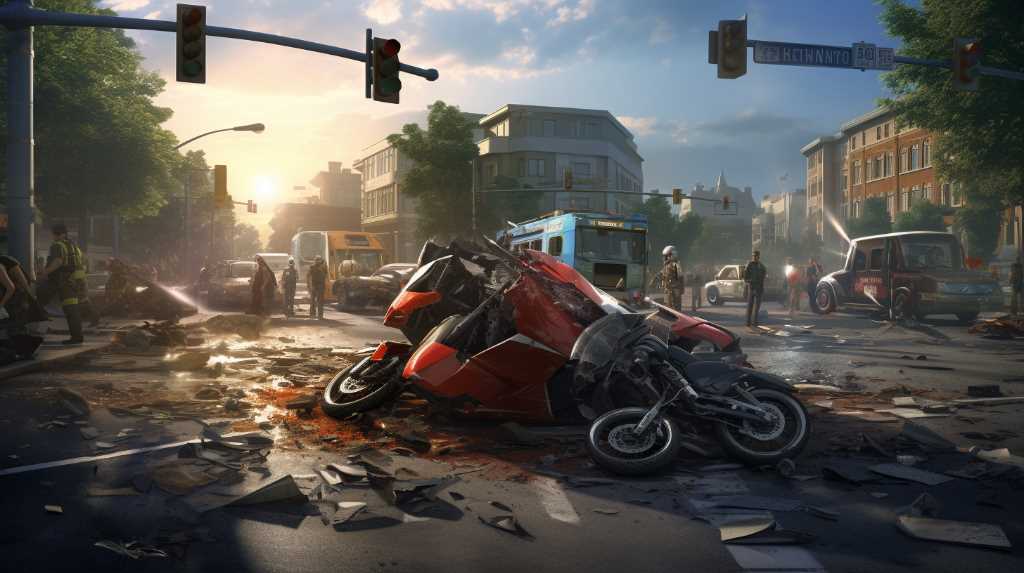
To figure out who is at fault in an accident between a bicycle and a motorcycle, you need to look closely at the details and understand the laws. It’s important because who is at fault affects who pays for damages.
The idea of comparative negligence is used to decide how much each person’s actions led to the accident. This means they check who broke traffic laws and how that affected the crash. They look at evidence from the scene, like skid marks and damaged vehicles, to help them understand what happened.
The laws in each state also play a part in deciding who is responsible. Insurance companies get involved too; they look into the accident and work out who pays what based on the insurance coverage and who was at fault.
Understanding Comparative Negligence
In assessing liability in a bicycle vs. motorcycle accident, one must understand the principle of comparative negligence, which apportions fault among the parties based on their respective contributions to the incident. This legal doctrine is pivotal as it directly influences the compensatory framework, requiring a meticulous evaluation of the actions of each party involved.
A thorough analysis of the accident scene, witness testimonies, and adherence to traffic laws is crucial. The determination of liability is not a blunt allocation of fault; rather, it is a nuanced calculation that reflects the complex dynamics of road-sharing scenarios.
Attorneys and insurers leverage this principle to negotiate settlement amounts, making it imperative for involved parties to be well-representative and informed. Comparative negligence ensures that justice is dispensed with a calibrated measure of responsibility, rather than an all-or-nothing approach.
Analyzing Traffic Law Violations
When figuring out who is to blame in an accident between a bike and a motorcycle, it’s important to look closely at any traffic laws that were broken. For example, if the biker didn’t stop at a stop sign, or the motorcycle rider was going too fast, these actions clearly point to who made the mistake. Not wearing a helmet or not having lights and reflectors at night can also affect who is responsible.
To understand the whole situation, you need to examine all the details carefully. This means looking at things like videos from traffic cameras, what witnesses say, and the actual place where the accident happened. This way, you can make a strong case about which person’s breaking of the traffic rules led to the crash.
Examining Accident Scene Evidence
Looking closely at what’s left behind after a bike and motorcycle crash can tell us a lot about what happened. Experts check out the skid marks, the damage to both rides, and where they ended up after the crash to piece together the event pretty precisely. They do this to figure out if one person was more to blame or if both had a part in it.
Taking photos, getting videos, and listening to people who saw it happen help give a full picture of the crash. Being thorough means experts won’t miss any important clues, which helps them decide who should be held responsible.
This is really important to make sure everyone involved gets treated fairly.
Impact of State-Specific Statutes
When figuring out who’s at fault in accidents between bicycles and motorcycles, we need to look at the evidence and understand the specific traffic laws of each state. These laws are different in every state and they can change who is responsible for the accident.
For example, laws about wearing helmets, who has the right to go first on the road, and sharing lanes are important. Some states have rules that say if a person is even a little bit at fault, they can’t get any money for damages. Other states reduce the money a person can get based on how much they were at fault.
Lawyers need to carefully study the traffic laws of the state where the accident happened. This helps them build a strong case to show who is at fault and defend their clients well according to the state’s legal rules.
Role of Insurance Companies
Insurance companies are really important when it comes to figuring out who has to pay for what after a bike and a motorcycle crash into each other. They look at all the details, like what the insurance policies say, the laws in the state, and what exactly happened during the accident. They do this to make sure the money that has to be paid is split fairly, based on who was at fault and what the insurance allows.
When they decide who should get what, they use evidence like police reports, what witnesses said, and how much damage there is. This doesn’t just help to sort out insurance claims; it also affects court cases if there are any. Because of this, we really need the unbiased judgment and know-how of insurance companies to sort out the messy details of who should be responsible in bike-versus-motorcycle accidents.
Conclusion
To work out who is at fault in an accident between a bicycle and a motorcycle, you need to look at everything very carefully. This means checking who broke traffic rules, looking at clues from where the accident happened, and knowing the laws of the state.
Also, insurance companies have a big part in deciding what happens after the accident. Because there are so many things to consider, figuring out who is to blame can be complicated.
It’s important to take a careful and detailed look at each accident because each one is different.